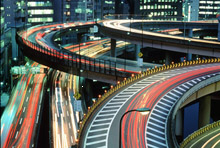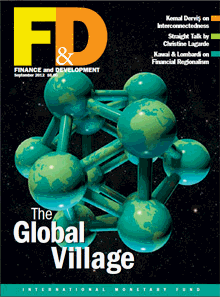
Typical street scene in Santa Ana, El Salvador. (Photo: iStock)
IMF Survey: The Global Village: Connected World Drives Economic Shift
August 30, 2012
- New convergence, interdependence profoundly changing world structure
- More interconnectedness in global economy brings benefits, contagion risks
- Global crisis requires supranational solutions, says IMF's Lagarde
The world economy is going through a major structural shift, with emerging markets rapidly catching up to advanced economies, says Kemal Dervis of the Brookings Institution.

Elevated highway interchange in Tokyo, Japan: the global economy is more interconnected than ever (photo: Jose Fuste Raga/Corbis)
WORLD ECONOMY
As the world becomes ever more multipolar and interdependent, multilateral solutions are needed to fight the risks and reap the rewards of integration, Dervis says in Finance & Development magazine.
Good news and bad
The complex interaction of trade, capital, information, and technology is leading to a new global convergence, for better and for worse. The surge in information enhances human lives—improving health, education, and communication. Trade and financial integration have underpinned strong growth and job creation and helped narrow the gap between rich countries and poor.

Division between rich and poor countries is blurring as technology becomes global commodity that developing and emerging economies import
But, as we have seen from the prolonged global financial crisis, our interconnectedness carries grave risks of contagion as well as benefits. Small economies can bring down large ones, and a disaster in one country has ripple effects around the world. The September 2012 issue of Finance & Development looks at different aspects of interconnectedness, globally and in Asia.
The global village
People now are interconnected at a level never seen before in history, says Kishore Mahbubani, Dean of the National University of Singapore’s Lee Kuan Yew School of Public Policy. Technology—in the form of mobile phones, the internet, Skype, and computers—is saving lives and connecting lives.
But global supply chains mean that a disruption on the other side of the world can affect what cars one can buy from the dealer down the street. Travelers transmit disease across continents with a single plane ride. And global warming challenges all nations to work together.
Mahbubani says the global village increasingly requires a “new global ethic” to save it—global solutions to big emerging problems such as financial crisis, flu outbreaks, and climate change. He expands on these ideas in his forthcoming book, The Great Convergence: Asia, the West, and the Logic of One World.
The division between rich and poor countries is blurring as technology becomes a global commodity that developing and emerging economies import and adapt to catch up with advanced economies. Dervis looks at three fundamental shifts in the global economy that are leading to major adjustments in the balance between east and west: convergence of emerging and advanced economies’ economic growth; interdependence of countries’ fortunes; and divergence of incomes within countries
Multipolar future
Dervis argues that the world of the future will be ever more multipolar and interdependent. This calls for emerging and developing countries to play a greater role in international institutions.
IMF Managing Director Christine Lagarde agrees, saying that while the IMF is making progress at mapping global financial risks and the links between the financial sector and the real economy, the biggest challenge is persuading national policymakers to take a global perspective.
Regional financial arrangements are one way to help underpin global financial stability, possibly with IMF help, write Masahiro Kawai, dean of the Asian Development Bank Institute, and Domenico Lombardi, president of The Oxford Institute for Economic Policy. They cite the Latin American Reserve Fund and the Chiang Mai Initiative, created by the 10 countries making up the Association of Southeast Asian Nations or ASEAN plus China, Korea, and Japan as models for other groups of countries to follow.
Moving abroad
Migration has been both a driving force and byproduct of globalization, says the president of the Migration Policy Institute, Demetrios Papademetriou. As a result of the global crisis, the future will see much more selective migration, with advanced economies less willing to accept unskilled immigrants.
But, again, a focus on immediate national objectives is short sighted. Investing in immigrants’ language abilities, health, and job skills is an investment in the host country’s future too. As advanced economies emerge from the crisis to encounter the reality of aging populations, they will need skilled immigrant workers to perform the jobs and pay the taxes that support the elderly.
Also in this issue, we profile Justin Yifu Lin, the World Bank’s first chief economist from an emerging economy, who discusses New Structural Economics as a method for rethinking sustainable development; look at how Myanmar is reintegrating into the global economy; hear what China and India can learn from each other; and examine proposals to broaden taxation of the financial sector in Europe.
■ Finance & Development is published four times a year, in English, Arabic, Chinese, French, Russian, and Spanish. The September 2012 issue is also being published in Japanese.







